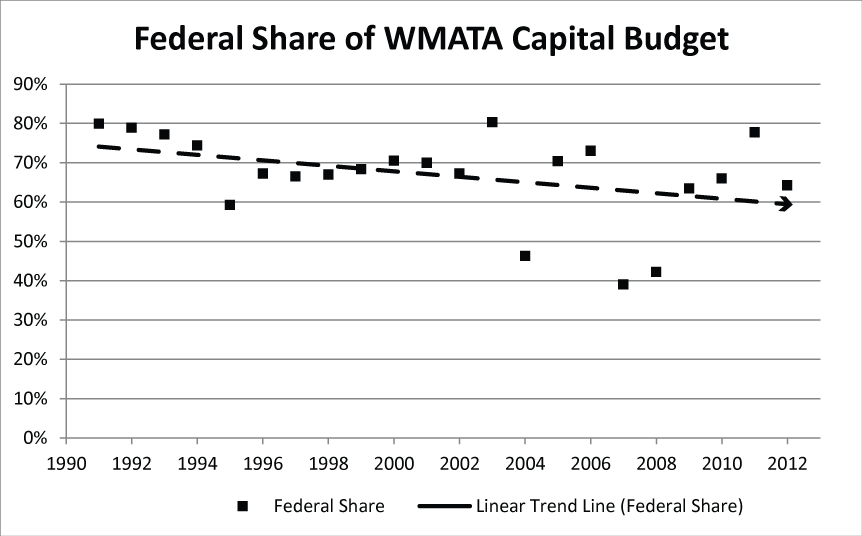Gut Check – Funding Metro 2025
Counting on the Feds alone to fund Metro ignores a long tradition of local jurisdiction funding support – and a ticking clock.
As the region grapples with mounting infrastructure needs (DC, MD and VA) regional leaders are experiencing a bit of sticker shock. That’s because this region has been enjoying the benefits of massive infrastructure capacity increases in transportation, water/sewer, and power that were built in the 1970s and were designed to keep up with growth for half a century.
Those fifty years have almost run out, as has our ability to grow into the capacity built by the previous generation of leaders. And if this region is going to continue its growth trajectory into the middle of this century, we’re going to need to invest in the supporting infrastructure capacities – including funding transit capacity increases via Metro 2025.
Some have argued that funding Metro improvements is primarily responsibility of the Federal government, or at least that the Federal government should lead this effort. That line of argument syncs up neither with the past, present or future – in reality, local jurisdictions have always played a significant role in funding Metro. Let’s lay out the facts about role of local jurisdictions in funding Metro.
- Fact: From 1969 to 1999, of the approximately $10.0 billion spent to construct the original 103-mile system, about $3.8 billion came from local jurisdictions, who always played a large role in the infrastructure investment:
- Fact: System enhancements, such as the Largo Extension and NoMA station, were largely paid for with local money. The Largo extension was paid for with 40% local money (DOC), and the NoMA station was funded with a combination of public and private local monies (PDF) that comprised more than 75% of the capital cost.
- Fact: As WMATA’s Capital Improvement Program (CIP) transitioned from a system expansion focus to more infrastructure renewal, the reliance on federal funding declined. Just look at the graphic below.
- Fact: While the 2008 Passenger Rail and Infrastructure Investment Act (PRIIA) authorizes $1.5 billion over ten years to support WMATA’s CIP, Congress was clear in mandating that this funding is contingent upon matching contributions from the region’s governments. In other words, without local jurisdiction funding commitments, monies from the Federal government would not materialize.
- Fact: Among the
25 largest transit operators in the nation, WMATA is one oftwothree that does not have a dedicated regional funding source. This despite being the second busiest subway and sixth busiest bus operator in the entire nation.
Those that monitor the Federal government know well that funding sources for major capital projects are in decline, and there are no guarantees to the legislative process. Just take a look at this graphic, from the U.S. Department of Transportation’s Highway Trust Fund Ticker.

The Mass Transit Account of the Federal Highway Trust Fund is forecast to be nearly empty by the end of Federal FY 2014. Click image for original Ticker page.
By the end of 2014, the mass transit account of the highway trust fund is projected to have about $400M in the bank – money that ostensibly will be spent nationally. Truth is, $400M doesn’t buy a whole lot of transit. Consider, for example that the entire balance of the mass transit account at the end of this year would get Metro about 147 new railcars – that’s about 2/3 of what Metro needs to run all eight-car trains. And that wouldn’t even touch traction power, storage, or maintenance facilities (the railcars have to be powered, stored, and maintained, of course).
And construction happens on a schedule and has never been able to wait for politics – in the case of Metro 2025, if Metro cannot execute the last option on its contract for 7000-series cars by August of 2015, the option expires and the region’s hopes for eight-car trains and much-needed capacity gets kicked at least five years further down the road.
Metro knows that the region needs these investments now. That’s why Metro’s proposed capital budget for Fiscal Year 2015 includes an additional $150 million, providing the first real down payment on the $6.5 billion Metro 2025 plan to fund some of the primary, critical nuts and bolts that are essential to improving capacity. And Metro is not hiding the ball – the cost goes up from there.
This additional $150 million in funding in FY15 is projected to be funded by the District of Columbia, Maryland and Virginia, and securing these funds will require regional consensus. Metro will continue to work with regional leaders to advocate for Federal support, but waiting for that support to materialize before beginning the much-needed investments in transit capacity is a dice roll at best. Instead, to deliver on Metro 2025, the region must come to terms with the current transit funding landscape, seek federal support for core capacity improvements, and recognize that a significant portion of Momentum must be funded regionally.
Who do you think should pay for Metro 2025?




Local funding was even more important in building Metro than these numbers say. Much of the federal share was diverted from canceled interstates. This was a local decision — local jurisdictions continue to have the option to use federal surface transportation money for WMATA capital expenses.